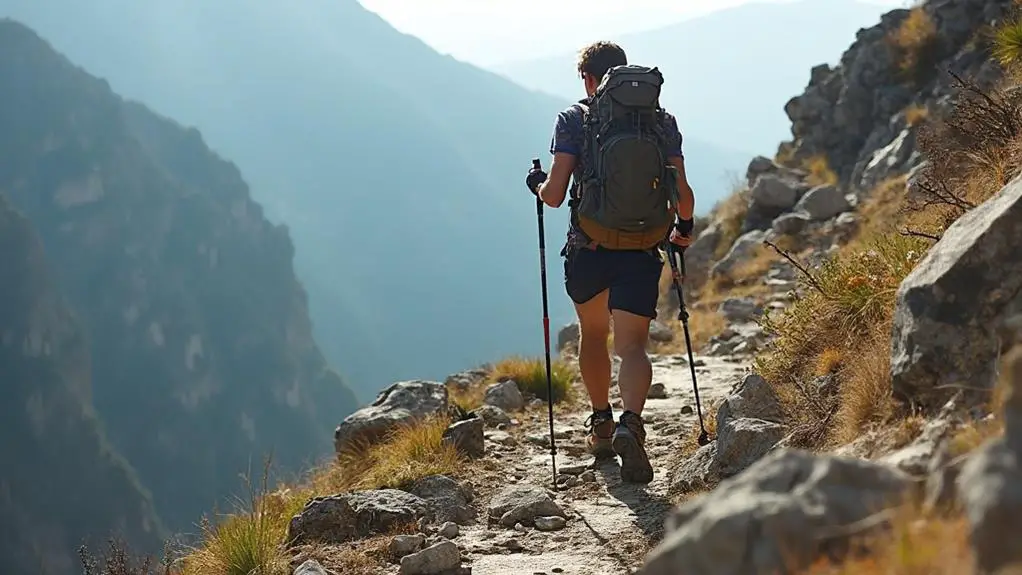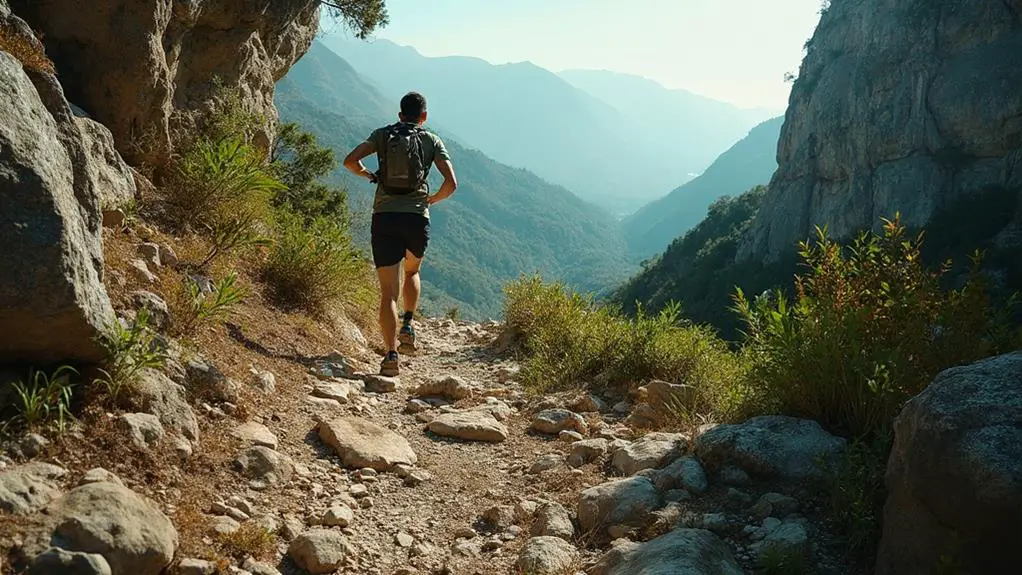To improve balance for maneuvering steep and rocky trails, focus on enhancing your stability, core strength, and proprioception through targeted exercises. Begin by evaluating your current fitness level with simple balance tests, like single-leg stands. Include core-strengthening routines, such as planks and Russian twists, at least twice a week. Dynamic balance drills, like heel-to-toe walking and agility ladders, bolster coordination. Employ trekking poles and balance boards to enhance stability further. Pair these physical practices with balanced nutrition and regular rest for ideal results. Embrace an extensive training schedule, and you'll discover refined skills and increased confidence on challenging terrains.
Key Takeaways
- Regularly practice core-strengthening exercises like planks and Russian twists to enhance stability and balance on challenging trails.
- Incorporate dynamic balance drills, such as single-leg stands and agility ladder exercises, to improve coordination and reduce fall risks.
- Use trekking poles and stability shoes to increase balance control and reduce fall risk on uneven surfaces.
- Train on varied terrains, including sloped and uneven surfaces, to enhance proprioception and muscle endurance.
- Integrate mindfulness techniques like yoga and mindful walking to improve body awareness and mental clarity for better balance.
Understanding the Importance of Balance
Balance plays a pivotal role in ensuring safe and enjoyable hiking experiences, particularly on uneven and steep terrains where stability can be easily compromised. For hikers, balance is not merely about preventing falls but also about enhancing the overall experience by steering through trails with confidence.
As individuals age, balance and proprioception—our body's ability to sense its position in space—naturally decline, making balance techniques and proprioception exercises essential components of hiking preparation.
Incorporating balance techniques into regular training can greatly reduce the risk of falls. Exercises such as single-leg stands, heel-to-toe walks, and utilizing balance boards can enhance proprioceptive abilities, thereby improving stability. Proprioception exercises are specifically designed to train the body's sensory receptors, enabling more precise movements and adjustments on uneven surfaces.
Furthermore, effective balance reduces physical strain and conserves energy, vital for endurance on long trails. By maintaining an efficient stride, hikers can traverse challenging environments with greater ease and less fatigue.
Ultimately, investing time in balance training not only boosts physical capability but also builds confidence, allowing hikers to tackle steep and rocky trails with assurance and enjoyment.
Assessing Your Current Fitness Level

To effectively prepare for hiking and guarantee a safe and enjoyable experience, it is important to assess your current fitness level. Conducting fitness assessments provides a baseline understanding of your cardiovascular fitness and muscular endurance, both essential for tackling steep and rocky trails.
Start with simple timed walks or runs to evaluate these areas. Additionally, perform a single-leg balance test to measure your balance and stability, important for traversing uneven terrain. This self-assessment will help identify areas needing improvement in your training plan.
Progress tracking is a critical component of any fitness journey. Maintaining a workout journal or using fitness apps allows you to document your endurance and strength improvements over time.
This data not only highlights areas of progress but also aids in adjusting your training regimen to guarantee continued development. Regularly revisiting these fitness assessments every few weeks is recommended to accurately monitor changes and adapt your plan accordingly.
Setting Achievable Balance Goals
Establishing realistic and specific balance goals is essential for enhancing your stability and performance on trails. Begin with a balance assessment to identify your current capabilities. This will help in setting tailored goals such as maintaining stability during one-leg stands for 30 seconds or completing 10 repetitions of various balance drills. By visualizing these goals, you can create a mental roadmap that guides your training process.
Incorporate a diverse range of exercises to improve your balance, such as heel-to-toe walking or using balance boards. These exercises enhance proprioception and adaptability to uneven terrains. Document your progress weekly, noting improvements in duration or repetitions, which allows for recalibration and the introduction of new challenges over time.
Short-term goals, achievable within weeks, such as mastering balance on grassy fields or rocky paths, can provide immediate feedback and confidence boosts.
Additionally, setting long-term goals like participating in guided hiking tours or tackling more demanding trails can sustain motivation and contribute to overall hiking proficiency.
Incorporating Core Strength Exercises

To enhance balance and control on challenging trails, it is essential to integrate core strength exercises into your routine.
Engaging core muscles through exercises such as planks and Russian twists has been shown to greatly improve stability, vital for maneuvering uneven terrain.
Core Muscle Engagement
Engaging your core muscles is fundamental for enhancing stability and balance, particularly when tackling challenging trails. Core stability is the foundation for effective movement, especially on steep and rocky paths. By incorporating a variety of exercises, such as planks and bridges, hikers can markedly improve their ability to navigate uneven terrain.
These exercises target the core muscles that are essential for maintaining balance and posture, reducing the risk of injury and fatigue. Incorporating rotational movements like Russian twists can further enhance core control. By strengthening the obliques, such movements increase one's ability to make quick adjustments on uneven surfaces.
Additionally, exercises like bird dogs and dead bugs are instrumental in promoting coordination between the upper and lower body. This coordination is critical for efficient movement, allowing for quicker reactions to changes in trail conditions.
Engaging in these targeted activities contributes to better posture and alignment, fundamental for long hikes. It also aids in improving the efficiency of movements, making it easier to handle the physical demands of steep inclines. For ideal results, hikers should regularly incorporate these exercises into their training regimen.
- Core stability exercises: Planks, bridges
- Rotational movements: Russian twists
- Coordination drills: Bird dogs, dead bugs
Stability and Control
While traversing challenging trails, the integration of core strength exercises is essential for maintaining stability and control. Core activation through exercises like planks and Russian twists enhances the support of the spine, critical for balance on steep and rocky terrains. These exercises engage the deep stabilizing muscles, which are fundamental for maintaining posture and alignment, thereby reducing the risk of falls and injuries.
Incorporating dynamic movements such as bird dogs and medicine ball throws can further enhance core engagement and improve proprioception. Proprioception is the body's ability to sense movement, action, and location, which is crucial for control on uneven surfaces. These balance techniques promote better coordination and muscle synchronization, necessary for safely traversing steep inclines and declines.
Research underscores that a robust core contributes markedly to improved balance. Regular practice of core-focused workouts, including stability ball exercises, has been shown to foster muscle coordination, enhancing the ability to maintain balance.
This is evidenced by increased time spent on one leg during stability tests, indicating a measurable improvement in balance. Therefore, incorporating these exercises into your routine can be an effective strategy for enhancing stability and control on challenging trails.
Strengthening Key Areas
Developing core strength is fundamental for enhancing stability and control on challenging hiking trails. A robust core aids in maintaining balance on steep and rocky terrains, allowing hikers to navigate uneven surfaces with confidence. Engaging in targeted core exercises not only enhances core flexibility but also bolsters muscle endurance, vital for prolonged outdoor activities.
Evidence-based exercises such as planks, side planks, and Russian twists specifically activate core muscles, enhancing overall stability. Incorporating dynamic movements, like mountain climbers and stability ball rollouts, further augments core strength by training the body to adjust to shifting surfaces. Research supports that a well-developed core greatly improves both balance and coordination, essential for peak performance in demanding hiking conditions.
To achieve noticeable improvements, it is recommended to regularly practice core-strengthening exercises for 15-20 minutes, 2-3 times a week. This consistent regimen will guarantee enhanced balance and stability on rocky trails.
Key exercises to take into account include:
- Planks and side planks: Improve core muscle endurance and stability.
- Russian twists: Enhance core flexibility and rotational strength.
- Mountain climbers: Boost dynamic core strength for adjusting to uneven surfaces.
Practicing Dynamic Balance Drills

Practicing dynamic balance drills plays an essential role in enhancing trail stability and improving proprioceptive skills, both of which are vital for safe and effective navigation of challenging terrains.
Engaging in exercises such as single-leg stands with eyes closed and heel-to-toe walking can markedly boost proprioception and coordination, thereby reducing the risk of falls on uneven surfaces.
Enhance Trail Stability
To enhance trail stability, incorporating dynamic balance drills into your routine is essential for improving coordination and stability on uneven terrain.
Balance techniques such as single-leg stands and balance board exercises are effective in bolstering your ability to maintain equilibrium. Aim for at least 30 seconds of hold time per leg, focusing on engaging the core and stabilizing muscles.
Coordination drills like heel-to-toe walking for 10-15 feet can greatly strengthen the stabilizing muscles of the feet and ankles, enhancing your ability to traverse rocky trails smoothly.
Incorporating agility ladder drills into your training regimen is also beneficial. These drills improve footwork and quickness, key factors in maintaining balance during abrupt changes in direction when traversing uneven paths.
Balance-focused strength training, such as weighted lunges or step-ups on unstable surfaces, effectively builds both strength and dynamic balance, essential for managing steep climbs and descents.
- Single-Leg Stands: Hold for at least 30 seconds per leg.
- Heel-to-Toe Walking: Practice for 10-15 feet to boost foot and ankle strength.
- Agility Ladder Drills: Enhance footwork and reaction speed for rocky trails.
Regularly participating in activities like yoga or Pilates further refines core strength and flexibility, reducing fall risk on challenging terrain.
Improve Proprioceptive Skills
Building upon the foundation of enhancing trail stability, improving proprioceptive skills is an integral component in mastering dynamic balance on uneven terrain. Proprioceptive training involves exercises that enhance the body's ability to sense its position and movement in space, which is vital for stability and coordination on challenging trails. Engaging in dynamic movements such as single-leg stands can greatly enhance these skills.
To additionally challenge and improve your proprioceptive system, incorporate lateral lunges or step-ups on unstable surfaces like balance boards or wobble cushions. These exercises not only strengthen the muscles essential for hiking but also enhance the body's reflexive response to uneven terrain.
Moreover, agility drills, such as cone weaving or ladder drills, cultivate quick reflexes and balance, necessary for effectively traversing rocky paths. Activities such as yoga or tai chi complement proprioceptive training by promoting body awareness and control.
Regular practice of dynamic balance drills can lead to a notable 30% improvement in balance stability, thereby considerably reducing the risk of falls on steep and rocky trails. Committing to a routine that incorporates these exercises will guarantee safer and more confident hiking experiences.
Enhancing Stability With Equipment

While traversing rugged and uneven trails, the use of specific equipment can greatly enhance stability and reduce the risk of injury. Trekking poles are invaluable for hikers; they redistribute weight and provide additional points of contact with the ground, reducing the risk of falls by up to 30%. This simple tool offers enhanced stability on steep and rocky paths, allowing hikers to maintain balance more effectively.
Incorporating a balance board into training routines is another effective strategy. Fitness studies indicate that using a balance board can increase balance performance by 30% by improving proprioception and core strength, essential components for trail navigation.
In addition to these, other equipment designed to enhance stability includes:
- Stability shoes: These feature a wider platform and enhanced traction, improving balance and control on uneven surfaces.
- Ankle weights: Utilized in training to strengthen the stabilizing muscles around the ankle joint, they enhance overall balance by up to 15%.
- Resistance bands: Used in strength training to improve lateral movement capabilities, they result in a 20% improvement in stability and coordination.
Training on Varied Terrains

How can hikers effectively prepare for the unpredictable challenges of rugged trails? Training on varied terrains is essential for developing terrain adaptability and managing balance variations. Engaging with different surfaces, such as rocky paths, grassy fields, and sandy areas, enhances proprioception, which is necessary for successfully maneuvering steep trails.
By incorporating exercises like lateral shuffles and agility ladder drills on uneven ground, hikers can improve their stability and coordination, better mimicking the real-world conditions of steep and rocky paths.
Additionally, hill workouts play an important role in strengthening leg muscles and developing balance. These sessions allow hikers to gain better control during ascents and descents on steep gradients.
Practicing on sloped surfaces, including both inclines and declines, further prepares the body for the specific demands of steep trails, enhancing muscle endurance and minimizing injury risk.
To complement outdoor training, using balance-focused tools such as balance boards or stability balls can greatly enhance core strength and stability.
This supplemental training is essential for maintaining balance on unpredictable rocky terrains, ensuring hikers are well-prepared for the diverse challenges they may encounter on their adventures.
Integrating Mindfulness in Training

Integrating mindfulness into hiking training can greatly enhance a hiker's ability to maintain balance and steer through challenging trails. By incorporating techniques such as mindful breathing and intentional movement, hikers can improve concentration and physical stability.
Mindful breathing, in particular, helps reduce anxiety and fosters mental resilience, enabling hikers to remain calm and focused when facing difficult terrain.
Practicing mindful walking is another effective strategy. This involves paying careful attention to each step and bodily sensations, thereby strengthening proprioception. This heightened body awareness facilitates better steering over uneven ground.
Additionally, engaging in disciplines like yoga or Pilates can enhance both physical balance and mental clarity. These activities promote intentional movement and body awareness, aiding stability on steep trails.
To maximize the effectiveness of mindfulness in training, hikers can set specific intentions for each session. For example, focusing on improving balance or increasing trail awareness leads to more targeted practice and improved performance in steep and rocky areas.
- Mindful Breathing: Reduces anxiety and enhances focus.
- Intentional Movement: Aids in maintaining physical balance.
- Mindful Walking: Strengthens proprioception and body awareness.
Incorporating these mindfulness strategies can greatly benefit hikers steering through challenging trails.
Choosing the Right Hiking Gear

Incorporating mindfulness into hiking practices enhances stability and focus, but equally important is equipping oneself with the right hiking gear to guarantee safety and performance on the trails. The choice of gear materials greatly impacts trail performance. Investing in sturdy hiking boots with proper boot fitment is essential; these should provide ankle protection to decrease the risk of sprains by 35%.
Attention to sock technology is also necessary; high-quality, moisture-wicking socks are imperative for effective moisture management, reducing friction and preventing blisters.
For ideal weight distribution, make sure your backpack is well-fitted and appropriately adjusted. This not only maintains a low center of gravity but also reduces strain and enhances balance.
Traction features in hiking boots, such as rubber outsoles with deep lug grip patterns, are crucial for increasing grip on rocky surfaces by up to 30%. Additionally, the pole benefits of using trekking poles are considerable; they help distribute weight, improve stability, and reduce knee load by approximately 25% during descents.
Selecting the right gear is integral to successfully maneuvering steep and rocky trails, guaranteeing both safety and enhanced trail performance.
Developing a Balanced Nutrition Plan

Developing a balanced nutrition plan is essential for hikers to maintain energy and optimize performance on trails. Key nutrient sources such as carbohydrates, proteins, and healthy fats should be strategically incorporated into meal timing to support energy levels and muscle recovery.
Additionally, selecting energy-rich snacks like nuts, seeds, and energy bars can provide quick and sustained energy, while staying hydrated is important to prevent fatigue and dehydration, especially during long treks.
Essential Nutrient Sources
A well-rounded nutrition plan is fundamental for hikers who wish to maintain energy and performance on challenging trails. The strategic timing of nutrient intake, known as nutrient timing, plays an indispensable role in optimizing energy levels and recovery.
Incorporating complex carbohydrates like whole grains and starchy vegetables is essential for sustained energy release, particularly on steep and rocky terrains. Lean proteins, such as chicken and legumes, support muscle repair and recovery, critical after strenuous physical exertion.
Hydration strategies are equally important. Hikers should aim to consume at least half their body weight in ounces of water daily, with adjustments for increased activity levels during hikes. Proper hydration prevents dehydration, which can impair performance and increase the risk of injury.
To guarantee thorough nutrient intake, include a variety of fruits and vegetables in your diet. These foods provide essential vitamins and minerals, like potassium and magnesium, that aid muscle function and reduce cramp risks during extended treks.
- Complex carbohydrates: Whole grains and starchy vegetables for sustained energy.
- Lean proteins: Chicken, fish, and legumes for muscle repair.
- Hydration: Drink sufficient water, adjusting for activity levels.
Meal Timing Strategies
Proper meal timing is a vital component of an effective nutrition plan for hikers aiming to enhance their performance on challenging trails. To achieve ideal energy balance, it is important to schedule meals and snacks strategically.
Begin with a balanced pre-hike meal, incorporating carbohydrates and proteins, approximately 2-3 hours before starting your trek. This timing guarantees adequate digestion while providing sustained energy and reducing the risk of fatigue during physical exertion.
During the hike, maintain energy levels by consuming energy-dense snacks, such as trail mix or energy bars, every 1-2 hours. This approach prevents muscle depletion and supports continuous performance on steep and rocky terrains.
Post-hike nutrition is equally significant; ingest a meal rich in protein and carbohydrates within 30 minutes to 2 hours after completing your hike. This promotes muscle recovery and replenishes glycogen stores essential for future activities.
Hydration is another key element in maintaining energy balance. Begin hydrating at least 24 hours prior to your hike and continue throughout and after your trek.
Energy-Rich Snack Options
When starting on challenging trails, selecting energy-rich snacks is essential for maintaining stamina and enhancing performance. Incorporating nutrient timing and well-planned snack combinations can greatly impact your hiking experience.
Nuts and seeds are excellent choices, providing healthy fats and proteins for sustained energy. Their slow-digesting nature guarantees a steady energy release, preventing abrupt fatigue during steep and rocky hikes.
Additionally, trail mix, which combines dried fruits and whole grains, offers a balanced source of carbohydrates and fiber. This combination not only provides quick energy release but also contributes to satiety, helping hikers sustain their energy levels over time.
Energy bars designed for athletes, containing 200-300 calories, can be an efficient option. These bars typically include a mix of carbohydrates, proteins, and healthy fats, supporting both endurance and muscle recovery.
To optimize performance, consider the following snack options:
- Nuts and Seeds: Rich in healthy fats and protein.
- Trail Mix: A blend of dried fruits and whole grains for balanced energy.
- Energy Bars: Contain carbohydrates, proteins, and fats for endurance.
Prioritizing Rest and Recovery

In the pursuit of ideal trail performance, one must not underestimate the power of rest and recovery. These components are fundamental to muscle repair and strength enhancement, essential for traversing steep and rocky trails.
Prioritizing sleep quality is imperative, as deep sleep stages release growth hormone, an essential element in facilitating recovery. Scheduling at least one full rest day per week is a strategic approach to prevent overtraining, ensuring your body is adequately prepared for upcoming hikes and workouts.
Incorporating active recovery techniques can further enhance your trail readiness. Practices such as stretching and foam rolling are effective methods to improve circulation and expedite healing.
These techniques not only support muscle recovery but also contribute to better overall performance. Listening to your body's signals, such as fatigue and soreness, is imperative; these cues guide the necessity to rest or modify training intensity, thereby preventing injuries.
Effective rest and recovery strategies improve endurance and balance, both significant for successfully managing challenging terrains.
Creating a Comprehensive Training Schedule

A well-structured training schedule is essential for enhancing trail performance, especially when traversing challenging terrains. To create an effective plan, it is vital to incorporate training variations that address both strength and endurance.
Establish a weekly routine that includes at least two non-consecutive days dedicated to strength training. Focus on exercises that enhance balance and core stability, significant for maneuvering steep and rocky trails. Complement these sessions with three non-consecutive days of cardio workouts, designed to build endurance and leg strength, fundamental for sustaining prolonged activity on difficult paths.
To further improve stability, integrate specific balance exercises, such as standing on one leg or heel-to-toe walking, at least three times weekly. Gradually increase the complexity of these exercises by incorporating uneven surfaces or balance tools like boards to closely mimic trail conditions.
- Include strength and cardio sessions on non-consecutive days.
- Perform balance exercises three times weekly on varied surfaces.
- Allocate one day for active recovery with flexibility and mobility exercises.
Allocate one day each week for active recovery, focusing on flexibility and mobility exercises such as yoga or Pilates.
Progress tracking through a training journal can provide valuable insights, helping to monitor improvements and adapt the schedule as needed.
Frequently Asked Questions
What Training Methods Improve Balance?
To enhance balance, incorporate core exercises and stability training. Focus on routines like yoga and Pilates to strengthen core muscles, and utilize tools like stability balls. Practicing on varied surfaces further improves adaptability and proprioception, enhancing overall stability.
How Do I Increase My Stamina for Hiking Uphill?
To increase uphill hiking stamina, integrate interval training for cardiovascular enhancement and practice proper breathing techniques to optimize oxygen efficiency. Gradually intensify training sessions, focusing on consistent progression, to build endurance and resilience on challenging terrains.
How to Get in Shape for Uphill Hiking?
To prepare for uphill hiking, integrate strength and endurance exercises alongside thorough trail preparation. Guarantee proper hiking equipment, including supportive footwear and trekking poles, to enhance stability and endurance, thereby optimizing physical readiness and safety on challenging terrains.
How to Strengthen Legs for Downhill Walking?
To enhance leg strength and refine downhill technique, focus on quadriceps-strengthening exercises such as squats and lunges. Incorporate step-downs, calf raises, and resistance band lateral movements to improve stability, endurance, and control during descent on varied terrains.
Conclusion
Improving balance for traversing steep and rocky trails requires a multifaceted approach that integrates physical fitness, proper equipment, and nutrition. Emphasizing core strength exercises and dynamic balance drills enhances stability and agility. Selecting appropriate hiking gear further supports safety and performance. A balanced nutrition plan and adequate rest are essential for recovery and sustained energy. By systematically evaluating fitness levels and setting realistic goals, individuals can develop an all-encompassing training schedule to effectively enhance balance capabilities.